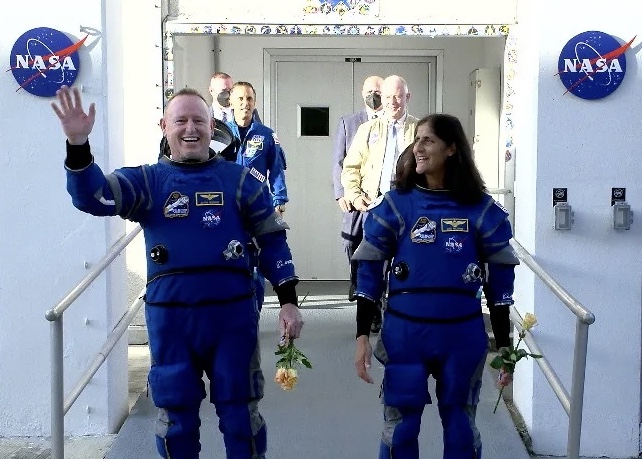Sunita Williams on historic third trip to Space Station

By Arun Kumar
Indian American astronaut makes history as the first woman to fly on the first flight of a crewed spacecraft
Indian American astronaut Sunita Williams is finally on her way to a history making third trip to the International Space Station on board NASA’s Boeing Crew Flight Test after several glitches.
The capsule, carrying pilot Williams and commander Butch Wilmore, is expected to reach the orbiting laboratory at 12:15 pm EDT, Thursday, June 6, according to NASA.
The astronauts lifted off at 10:52 am EDT Wednesday on a ULA (United Launch Alliance) Atlas V rocket from Space Launch Complex-41 at Cape Canaveral Space Force Station in Florida on an end-to-end test of the Starliner system.
“Two bold NASA astronauts are well on their way on this historic first test flight of a brand-new spacecraft,” said NASA Administrator Bill Nelson. “Boeing’s Starliner marks a new chapter of American exploration. Human spaceflight is a daring task – but that’s why it’s worth doing. It’s an exciting time for NASA, our commercial partners, and the future of exploration. Go Starliner, Go Butch and Suni!”
The crew flight test mission makes history in several ways. As the first crewed launch of Boeing’s Starliner spacecraft, Williams is the first female astronaut to fly on the first flight of a crewed spacecraft.
The launch also marks the first crewed launch on the ULA Atlas V rocket and the first crewed launch on an Atlas-family class rocket since Gordon Cooper on the last Mercury program flight aboard “Faith 7” in May 1963.
For NASA missions to low Earth orbit, the Starliner capsule, with a diameter of 15 feet, will hold four astronauts or a mix of crew and cargo.
Inside Starliner for this mission is about 759 pounds of cargo, which includes food, clothing, exercise gear, medical supplies, photo and media equipment, vehicle supplies and tools, and other items. A thumb drive containing about 3,500 images of artwork from children in 35 states and 66 different countries is also on board.
Williams brought shirts from the US Naval Academy and the Sunita L. Williams Elementary School in Needham, Massachusetts. She also has a diver pin and two dog tags from her Labrador retrievers.
Measuring 10 feet in diameter and 41.5 feet in length, the Centaur upper stage uses liquid hydrogen and liquid oxygen to power its twin Aerojet Rocketdyne RL10A-4-2 engines. The burn of the Centaur’s dual engines is expected to last a little more than seven minutes before engine cutoff and separation from Starliner.
Following separation, the crew capsule carrying NASA astronauts Butch Wilmore and Suni Williams will be on its own for the remainder of the journey to the space station. The Atlas Centaur will then land in the ocean near Australia.
Williams and Wilmore spent about an hour putting on their suits and completing suit leak checks inside the Neil A. Armstrong Operations and Checkout Building at the agency’s Kennedy Space Center in Florida. After departing the building, they waved to family and friends waiting outside before loading into Boeing’s Astrovan for the drive to the launch pad.
The duo will spend about a week at the space station before the crew capsule makes a parachute and airbag-assisted landing in the southwestern United States.
Once the flight test is complete, NASA will begin the final process of certifying Starliner and its systems for regular human spaceflight launches.
In 2012, during a prior trip to the International Space Station, Williams became the first person to finish a triathlon in space, during which she simulated swimming using a weight-lifting machine and ran on a treadmill while strapped in by a harness so she wouldn’t float away.
That came after she ran the Boston Marathon from the space station in 2007.
Williams received her commission as an Ensign in the United States Navy from the United States Naval Academy in May 1987. Williams was selected as an astronaut by NASA in 1998 and is a veteran of two space missions, Expeditions 14/15 in 2006 and 32/33 and 2012.
